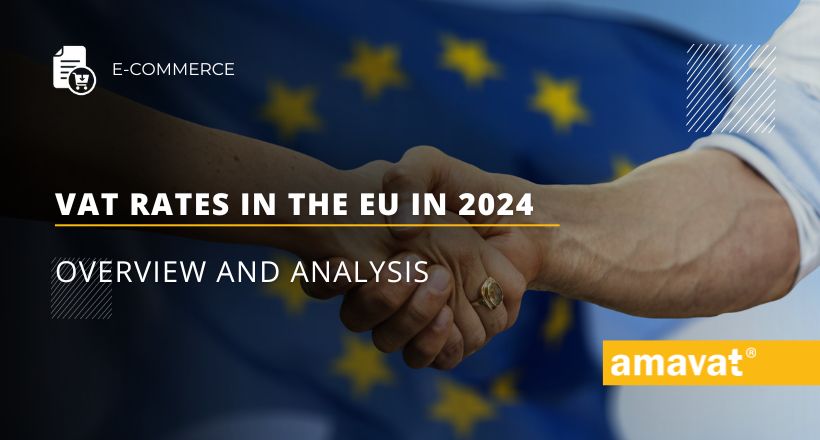VAT rates in the EU in 2024: Overview and analysis
Value added tax (VAT) is one of the main sources of budget revenues in European Union (EU) countries. As an indirect tax, VAT is included in the price of goods and services, ultimately paid by the consumer. Although the European Union sets minimum VAT requirements, individual Member States have considerable freedom to adapt their tax systems. Let’s take a closer look at the VAT rates across the EU in 2024 and how they vary between countries.
VAT rates in European countries for 2024
Below is a detailed table that outlines the standard and reduced VAT rates in Europe for 2024:
| Country | Standard VAT rate | Reduced VAT rate |
|---|---|---|
| Austria VAT | 20% | 10%, 13% |
| Belgium VAT | 21% | 6%, 12% |
| Bulgaria VAT | 20% | 9% |
| Croatia VAT | 25% | 5%, 13% |
| Cyprus VAT | 19% | 5%, 9% |
| Czech Republic VAT | 21% | 12% (consolidated from 10% and 15%) |
| Denmark VAT | 25% | – |
| Estonia VAT | 22% (20% im 2023) | 5%, 9% |
| Finland VAT | 24% | 10%, 14% |
| France VAT | 20% | 2.1%, 5.5%, 10% |
| Greece VAT | 24% | 6%, 13% |
| Spain VAT | 21% | 4%, 10% |
| Netherlands VAT | 21% | 9% |
| Ireland VAT | 23% | 4.8%, 9%, 13.5% |
| Luxembourg VAT | 17% | 3%, 8%, 14% |
| Lithuania VAT | 21% | 5%, 9% |
| Latvia VAT | 21% | 5%, 12% |
| Malta VAT | 18% | 5%, 7% |
| Germany VAT | 19% | 7% |
| Poland VAT | 23% | 5%, 8% |
| Portugal VAT | 23% (22% Madeira, 16% Azores) | 6% (5% Madeira, 4% Azores), 13% (12% Madeira; 9% Azores) |
| Romania VAT | 19% | 5%, 9% |
| Slovakia VAT | 20% | 10% |
| Slovenia VAT | 22% | 5%, 9.5% |
| Switzerland VAT | 8.1% (7.7% in 2023) | 2.6% (2.5% in 2023), 3.8% (3.7% in 2023) |
| Sweden VAT | 25% | 6%, 12% |
| Hungary VAT | 27% | 5%, 18% |
| United Kingdom VAT | 20% | 5% |
| Italy VAT | 22% | 4%, 5%, 10% |
Standard VAT rates
The standard VAT rate is the general rate applied to most goods and services. It serves as the base rate from which countries determine their other, reduced rates. In 2024, Luxembourg has the lowest basic VAT rate in Europe, at 17%. This is particularly noteworthy because Luxembourg, one of the wealthiest EU countries, opts for a more competitive VAT rate, potentially attracting investors and consumers.
On the opposite end, Hungary has the highest standard VAT rate at 27%. Such a high rate significantly impacts the final prices of goods and services, influencing consumption and purchasing decisions. The difference in VAT rates between Luxembourg and Hungary perfectly illustrates how different approaches to tax policy can be in the EU.
Reduced VAT rates
Reduced VAT rates are applied to lower the cost of essential goods and services, often of significant social importance. In 2024, many EU countries are introducing various reduced rates to support specific sectors or societal groups. For example:
- France: Offers reduced rates of 10%, 5.5%, and a super-reduced rate of 2.1%, covering items like food, books, and passenger transport.
- Spain: Provides 10% and a super-reduced 4% rate for items such as certain food products, newspapers, and hospitality services.
- Germany: Applies a single reduced rate of 7% for goods like food, medical services, and cultural events.
Denmark stands out as the only EU country without any reduced VAT rates. All goods and services there are taxed at the standard VAT rate of 25%.
Super-reduced VAT rates
Super-reduced VAT rates, under 5%, are applied by several European countries to items deemed crucial for society. In 2024, these rates are seen in countries like:
- Spain: 4% for pharmaceuticals, social services, newspapers and more.
- Luxembourg: 3% for food products, children’s items, books and more.
- Italy: 4% for medical devices for disabled persons, TV licenses, social housing and more.
These rates are often used to facilitate access to essential goods and services, which helps alleviate the economic impact on consumers, especially those with lower incomes.
VAT calculation principles
VAT is charged at the last stage of sale, i.e. when the goods or services reach the final consumer. This means consumers pay VAT when purchasing goods and services they ultimately acquire. In EU countries, VAT is applied according to the rates in the country of purchase.
For businesses operating across multiple EU countries, understanding the €10,000 sales threshold is crucial. Once a business exceeds this sales amount in a country, it must register for VAT there and account for VAT in that country or use the VAT OSS (One Stop Shop) procedure. The VAT OSS allows businesses to consolidate VAT reporting for sales across different EU countries into a single return.
Summary
The VAT rates in EU countries for 2024 reveal a wide range of approaches to managing this tax. Each country has its unique factors influencing the setting of standard, reduced, and super-reduced rates. For businesses operating internationally, understanding these differences and their implications is essential.
Given the diverse VAT rates, companies and consumers need to be aware of how tax regulations affect the prices of goods and services they buy or sell. By understanding these differences, you can better plan and manage costs and effectively use the opportunities offered by the EU single market
For expert guidance to avoid misunderstandings and ensure compliance with current regulations, please contact us – amavat®.





